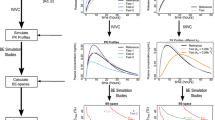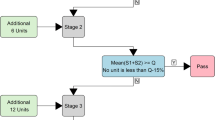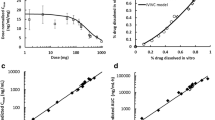Abstract
An intrauterine system (IUS) can be implanted in the uterus and deliver drug directly at the site of pharmacological action. Mirena was the first FDA-approved levonorgestrel (LNG) releasing IUS without an approved generic form. Its 5-year application duration presents challenges for bioequivalence (BE) assessment using the conventional in vivo studies with pharmacokinetic and/or comparative clinical endpoints. Conventionally, along with other conditions, BE could be established if the 90% confidence interval (CI) of the ratio of geometric means of residual LNG at the end of 5 years is within the BE limits of 80.00% and 125.00%. Modeling and simulation were conducted to identify a shortened BE study duration and its corresponding BE acceptance limit that can be used as a surrogate for the conventional limit for a 5-year study. Simulation results suggest that having the 90% CI of the residual LNG 12 months post insertion within 95.00–105.26% would ensure that residual LNG amount at 5 years to be within 80.00–125.00%. This modeling and simulation practice leads to the current BE recommendation: if a test IUS is made of the same material in the same concentration and has the same physical dimensions as the Mirena, its BE could be established by showing (1) comparative physicochemical and mechanical properties; (2) comparative in vitro drug release behavior for 5 years; and (3) performance in a comparative short-term in vivo study and BE based on 90% confidence interval of test and reference ratio of residual LNG to be within 95.00–105.26% at month 12.
Graphical Abstract









Similar content being viewed by others
References
Sharan S, Wang Y, Donnelly M, Zou Y, Fang L, Kim MJ, et al. Regulatory science to promote access to intrauterine systems for women in the United States. J Clin Pharmacol. 2020;60(Suppl 2):S34–8. https://doi.org/10.1002/jcph.1710.
Pregnancy prevention, birth control methods. U. S. Department of Health and Human Services (HHS), Office of Population Affairs (OPA); [02/10/2020]; Available from: https://www.hhs.gov/opa/pregnancy-prevention/birth-control-methods/index.html.
Birth Control. U.S Food & Drug Administration; [updated 02/11/202002/24/2020]; Available from: https://www.fda.gov/consumers/free-publications-women/birth-control.
Contraceptive Use in the United States. Guttmacher Institute; [updated 07/201802/25/2020]; Available from: https://www.guttmacher.org/fact-sheet/contraceptive-use-united-states.
Birgisson NE, Zhao Q, Secura GM, Madden T, Peipert JF. Preventing unintended pregnancy: the contraceptive CHOICE project in review. J Womens Health (Larchmt). 2015;24(5):349–53. https://doi.org/10.1089/jwh.2015.5191.
Peipert JF, Madden T, Allsworth JE, Secura GM. Preventing unintended pregnancies by providing no-cost contraception. Obstet Gynecol. 2012;120(6):1291–7. https://doi.org/10.1097/aog.0b013e318273eb56.
Secura GM, Madden T, McNicholas C, Mullersman J, Buckel CM, Zhao Q, et al. Provision of no-cost, long-acting contraception and teenage pregnancy. N Engl J Med. 2014;371(14):1316–23. https://doi.org/10.1056/NEJMoa1400506.
FDA. Generic Competition and Drug Prices. 2019.
Monea E, Thomas A. Unintended pregnancy and taxpayer spending. Perspect Sex Reprod Health. 2011;43(2):88–93. https://doi.org/10.1363/4308811.
Sonfield A, Kost K, Gold RB, Finer LB. The public costs of births resulting from unintended pregnancies: national and state-level estimates. Perspect Sex Reprod Health. 2011;43(2):94–102. https://doi.org/10.1363/4309411.
Lionberger RA. FDA critical path initiatives: opportunities for generic drug development. AAPS J. 2008;10(1):103–9. https://doi.org/10.1208/s12248-008-9010-2.
FDA Label Mirena (SUPPL-38). U.S Food & Drug Administration; [updated 06/08/201702/24/2020]; Available from: https://www.accessdata.fda.gov/drugsatfda_docs/label/2017/021225s038lbl.pdf.
Attia AM, Ibrahim MM, Abou-Setta AM. Role of the levonorgestrel intrauterine system in effective contraception. Patient Prefer Adherence. 2013;7:777–85. https://doi.org/10.2147/PPA.S36948.
Silverberg SG, Haukkamaa M, Arko H, Nilsson CG, Luukkainen T. Endometrial morphology during long-term use of levonorgestrel-releasing intrauterine devices. Int J Gynecol Pathol. 1986;5(3):235–41. https://doi.org/10.1097/00004347-198609000-00005.
New evidence linking greater generic competition and lower generic drug prices. [Webpage]: U.S Food & Drug Administration; [updated 12/13/201901/17/2020]; Available from: https://www.fda.gov/about-fda/center-drug-evaluation-and-research-cder/generic-competition-and-drug-prices.
Ricketts S, Klingler G, Schwalberg R. Game change in Colorado: widespread use of long-acting reversible contraceptives and rapid decline in births among young, low-income women. Perspect Sex Reprod Health. 2014;46(3):125–32. https://doi.org/10.1363/46e1714.
Kavanaugh ML, Frohwirth L, Jerman J, Popkin R, Ethier K. Long-acting reversible contraception for adolescents and young adults: patient and provider perspectives. J Pediatr Adolesc Gynecol. 2013;26(2):86–95. https://doi.org/10.1016/j.jpag.2012.10.006.
Draft guidance on levonorgestrel intra uterine device. U.S Food & Drug Administration; [updated 01/202003/11/2020]; Available from: https://www.accessdata.fda.gov/drugsatfda_docs/psg/PSG_021225.pdf.
Statistical approaches to establishing bioequivalence. U.S. Food & Drug Administration; [updated 02/200105/04/2020]; Available from: https://www.fda.gov/media/70958/download.
FDA guidance applications covered by section 505(b)(2). U.S. Food & Drug Administration; [updated 04/27/202004/12/2022]; Available from: https://www.fda.gov/media/72419/download.
Acknowledgements
Authors thank Joanne Berger (FDA Library) for manuscript editing assistance.
Author information
Authors and Affiliations
Contributions
Conception design or planning of the study: Satish Sharan, Sungwoo Choi, Fairouz Makhlouf, Stella C Grosser, Xinyuan Zhang, Stephanie Choi, and Liang Zhao.
Acquisition of the data: Satish Sharan and Sungwoo Choi.
Analysis of the data: Satish Sharan and Sungwoo Choi.
Interpretation of the results: Satish Sharan, Sungwoo Choi, Xinyuan Zhang, Fairouz Makhlouf, Stella C Grosser, and Liang Zhao.
Critically reviewing or revising the manuscript for important intellectual content: Satish Sharan, Sungwoo Choi, Yuan Zou, Yan Wang, Myong-Jin Kim, Lanyan Fang, Stephanie Choi, Fairouz Makhlouf, Stella C Grosser, Xinyuan Zhang, and Liang Zhao.
Corresponding author
Ethics declarations
Competing Interests
The authors declare no competing interests.
Additional information
Publisher's Note
Springer Nature remains neutral with regard to jurisdictional claims in published maps and institutional affiliations.
Supplementary Information
Below is the link to the electronic supplementary material.
Rights and permissions
About this article
Cite this article
Sharan, S., Choi, S., Zou, Y. et al. Application of Modeling and Simulation to Identify a Shortened Study Duration and Novel Bioequivalence Metric for a Long-Acting Intrauterine System. AAPS J 24, 63 (2022). https://doi.org/10.1208/s12248-022-00715-z
Received:
Accepted:
Published:
DOI: https://doi.org/10.1208/s12248-022-00715-z




